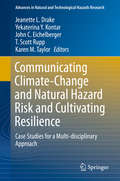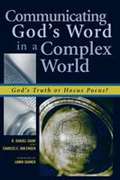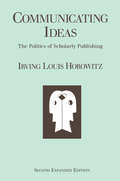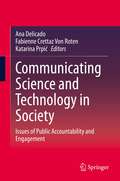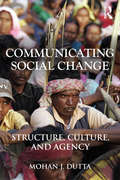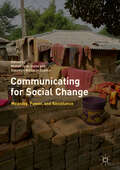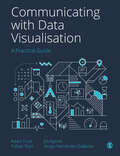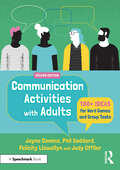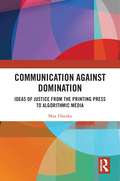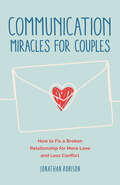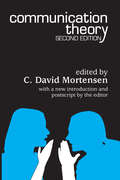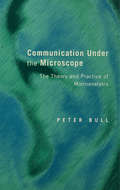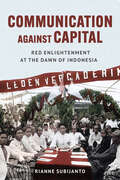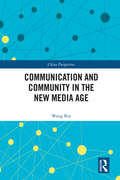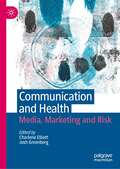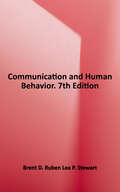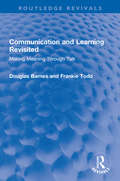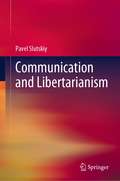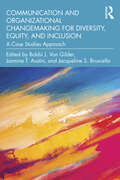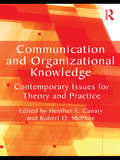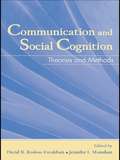- Table View
- List View
Communicating Climate-Change and Natural Hazard Risk and Cultivating Resilience: Case Studies for a Multi-disciplinary Approach (Advances in Natural and Technological Hazards Research #45)
by Jeanette L. Drake Yekaterina Y. Kontar John C. Eichelberger T. Scott Rupp Karen M. TaylorThis edited volume emphasizes risk and crisis communication principles and practices within the up-to the minute context of new technologies, a new focus on resiliency, and global environmental change. It includes contributions from experts from around the globe whose research, advocacy, teaching, work, or service in the natural or social sciences deals with risk communication and/or management surrounding natural and technological disasters, with a particular focus on climate change-related phenomena. Resilience and good communication are intimately linked and with climate change precipitating more numerous and onerous weather-related catastrophes, a conversation on resilience is timely and necessary. The goal is robust communities that are able to withstand the shock of disaster. Communicating well under ordinary circumstances is challenging; communicating during a crisis is extraordinarily difficult. This book is dedicated to all those who have directly or indirectly suffered the effects of climate change end extreme events with the hope that the advance of knowledge, implementation of sound science and appropriate policies and use of effective communication will help in reducing their vulnerability while also improving resilience in the face of often devastating natural and technological disasters.
Communicating God's Word In A Complex World: God's Truth Or Hocus Pocus?
by Charles E. Van Engen Lamin Sanneh R. ShawCommunicating God's Word in a Complex World reaches out to the growing number of missionaries, pastors, Bible translators and teachers, mission and theological educators and students dealing with communicating the gospel. This is increasingly difficult in today's pluralist and global contexts. What was God's message, and how has spreading that message changed through the generations? The answer to that question requires a hermeneutical process that seeks to understand the biblical text and the context in which it was originally presented. R. Daniel Shaw and Charles Van Engen say that contemporary proclaimers of God's word can model their approach after that of the writers of scripture, who reinterpreted and restated their received texts for their audiences. Thus, Gospel communication is impacted by the way humans know God. This, in turn, is informed by contexts. Communicating God's Word in a Complex World draws lessons from the biblical authors themselves as a guide for how best to present God's message.
Communicating Ideas: The Politics of Scholarly Publishing
by Irving Louis HorowitzCommunicating Ideas is the first attempt to place publishing in America in its political and commercial setting. The book addresses the political implications of scholarly communication in the era of the new computerized technology. Horowitz does so by examining classic problems of political theory in the context of property rights versus the presumed right to know, and the special strains involved in publishing as a business versus information as a public trust Offering a knowledgeable and insightful view of publishing in America and abroad, this book makes an important contribution to the study of mass culture in advanced societies.The discussion ranges considerably beyond scholarly publications into communication as a whole, encompassing a wide range of issues from cable and satelite television control to specialized issues in copyright legislation, the prize system in publishing, and the definition of standards of the industry. This new edition, expanded by fully one third, expands on such themes, and in addition deals with Horowitz's new research on the history of social science publishing.The first edition, published in 1986, was described by WE. Coleman as "a marvelous book which indeed offers a realistic analysis of publishing." John P. Dessauer declared that "no one thinking seriously about the future of scholarly communication can afford to ignore his work, in particular his treatment of basic issues." Joseph Gusfield (Los Angeles Times), in his review, noted that "Horowitz is alive to the possibilities and barriers for academics to reach a wider audience and for lay persons to utilize scholarship. Both groups can learn much from this intelligent book." And Philip G. Altbach (Scholarly Publishing) concluded his review by saying that Communicating Ideas "will be of interest not only to publishers and editors, but also to librarians and to sociologists of science."
Communicating Science and Technology in Society: Issues of Public Accountability and Engagement
by Ana Delicado Fabienne Crettaz Von Roten Katarina PrpićThis volume addresses the engagement between science and society from multiple viewpoints. At a time when trust in experts is being questioned, misinformation is rife and scientific and technological development show growing social impact, the volume examines the challenges in involving the public in scientific debates and decisions. It takes into account societal needs and concerns in research, and analyses the interface between the roles of institutions and individuals. From environmental challenges to science communication, participatory technological design to animal experimentation, and transdisciplinarity to norms and values in science, the volume brings together research on areas in which scientists and citizens interact, across diverse, often understudied, socio-cultural contexts in Europe. It encompasses the natural sciences, engineering and the social sciences, and the chapters follow diverse theoretical frameworks and methodologies, including both quantitative and qualitative approaches. This volume contributes not just to scholarly knowledge on the topic of science and society relations, but also provides useful information for students, policy makers, journalists, and STEM (science, technology, engineering and mathematics) researchers keen on engaging with their publics and conducting responsible research and innovation.
Communicating Social Change: Structure, Culture, and Agency (Routledge Communication Series)
by Mohan J. DuttaCommunicating Social Change: Structure, Culture, and Agency explores the use of communication to transform global, national, and local structures of power that create and sustain oppressive conditions. Author Mohan J. Dutta describes the social challenges that exist in current globalization politics, and examines the communicative processes, strategies, and tactics through which social change interventions are constituted in response to the challenges. Using empirical evidence and case studies, he documents the ways through which those in power create conditions at the margins, and he provides a theoretical base for discussing the ways in which these positions of power are resisted through communication processes, strategies, and tactics. The interplay of power and control with resistance is woven through each of the chapters in the book. This exceptional volume highlights the points of intersection between the theory and praxis of social change communication, creating theoretical entry points for the praxis of social change. It is intended for communication scholars and students studying activism, social movements, and communication for social change, and it will also resonate in such disciplines such as development, sociology, and social work, with those who are studying social transformations.
Communicating for Social Change: Meaning, Power, and Resistance
by Mohan Jyoti Dutta Dazzelyn Baltazar ZapataThe book covers the trajectories and trends in social change communication, engaging the key theoretical debates on communication and social change. Attending to the concepts of communication and social change that emerge from and across the global margins, the book works toward offering theoretical and methodological lessons that de-center the dominant constructions of communication and social change. The chapters in the book delve into the interplays of academic-activist-community negotiations in communication for social change, and the ways in which these negotiations offer entry points into transformative communication processes of social change. Moreover, a number of chapters in the book attend to the ways in which Asian articulations of social change are situated at the intersections of culture, structure, and agency. Chapters in the book are extended versions of research presented at the conference on Communicating Social Change: Intersections of Theory and Praxis held at the National University of Singapore in 2016, organized under the umbrella of the Center for Culture-Centered Approach to Research and Evaluation (CARE).
Communicating with Data Visualisation: A Practical Guide
by Adam Frost Tobias Sturt Jim Kynvin Sergio GallardoHow can you transform a spreadsheet of numbers into a clear, compelling story that your audience will want to pass on? This book is a step-by-step guide (honed through the authors′ Guardian masterclasses, workshops and seminars) to bringing data to life through visualisations, from static charts and maps to interactive infographics and motion graphics. Introducing a four-step framework to creating engaging and innovative visualisations, it helps you to: · Find the human stories in your datasets · Design a visual story that will resonate with your audience · Make a clear, persuasive visual that represents your data truthfully · Refine your work to ensure your visual expresses your story in the best possible way. This book also includes a portfolio of best-practice examples and annotated templates to help you choose the right visual for the right audience, and repurpose your work for different contexts.
Communicating with Data Visualisation: A Practical Guide
by Adam Frost Tobias Sturt Jim Kynvin Sergio GallardoHow can you transform a spreadsheet of numbers into a clear, compelling story that your audience will want to pass on? This book is a step-by-step guide (honed through the authors′ Guardian masterclasses, workshops and seminars) to bringing data to life through visualisations, from static charts and maps to interactive infographics and motion graphics. Introducing a four-step framework to creating engaging and innovative visualisations, it helps you to: · Find the human stories in your datasets · Design a visual story that will resonate with your audience · Make a clear, persuasive visual that represents your data truthfully · Refine your work to ensure your visual expresses your story in the best possible way. This book also includes a portfolio of best-practice examples and annotated templates to help you choose the right visual for the right audience, and repurpose your work for different contexts.
Communication Accommodation Theory
by Howard GilesMost people modify their ways of speaking, writing, texting, and e-mailing, and so on, according to the people with whom they are communicating. This fascinating book asks why we 'accommodate' to others in this way, and explores the various social consequences arising from it. Communication Accommodation Theory (CAT), revised and elaborated over the past 40 years, has been applied to a wide range of situations, from families to courtrooms, and from media to hospitals, by means of diverse methodologies in many disciplines, and across numerous languages and cultures. Bringing together a team of experts, this book demonstrates how the theory can help us towards a greater understanding of interpersonal communication in a multitude of contexts. Finally, it examines the principles of the theory, identifying a range of avenues along which research can move forward in future.
Communication Activities with Adults
by Jayne Comins Felicity Llewellyn Judy OffilerWith more than 100 graded communication activities for individuals and groups, this practical book is an excellent resource for health professionals and activity providers. An extensively revised and updated form of the extremely popular "Activities Ideas", which was originally published in 1983, this book was originally compiled for use with people with dysphasia. This book is also valuable for working with the elderly and day-centre clients, and can be used for group warm-ups. The majority of activities require little or no preparation and can be adapted to suit different abilities.
Communication Activities with Adults: 100+ Ideas for Word Games and Group Tasks
by Jayne Comins Felicity Llewellyn Judy Offiler Phil GoddardProviding over 100 ideas for word games and group activities, this book is the perfect timesaver for the busy practitioner. The instructions for each activity have been kept to a minimum, so you can easily adapt it to your clients’ communication, cognitive, and reading skills. This is a new edition of a book that has been in print for over forty years. It includes brand-new activities and a full update of existing ones to make them relevant to the 2020s. Tasks are divided into three sections: Short Answers, suitable for limited communication or quick-fire tests; more demanding Longer Answers that require a series of words or sentences; and Longest Answers, for more open-ended tasks and group work. The handbook will allow anyone working with groups and individuals with communication difficulties to plan sessions quickly and easily. It has long been an essential part of the toolkit for every speech and language therapist, care professional, and activity provider. Most importantly, it is intended to get people talking, and to make therapy fun for you and your clients.
Communication Against Domination: Ideas of Justice from the Printing Press to Algorithmic Media
by Max HänskaThis book tackles the philosophical challenge of bridging the gap between empirical research into communication and information technology, and normative questions of justice and how we ought to communicate with each other. It brings the question of what justice demands of communication to the center of social science research. Max Hänska undertakes expansive philosophical analysis to locate the proper place of normativity in social science research, a looming subject in light of the sweeping roles of information technologies in our social world today. The book’s first section examines metatheoretical issues to provide a framework for normative analysis, while the second applies this framework to three technological epochs: broadcast communication, the Internet and networked communications, and the increasing integration of artificial intelligence and machine learning technologies into our communication systems. Hänska goes beyond the prevailing frameworks in the field by exploring how we answer normative questions and how our answer can change depending on our social context and the affordances of prevailing communications technologies. This book provides an essential guide for scholars as well as graduate and advanced undergraduate students of research and theory in communication, philosophy, political science, and the social sciences.
Communication Miracles for Couples: How to Fix a Broken Relationship for More Love and Less Conflict
by Jonathan RobinsonLearn How to Fix A Broken Relationship“The simplest, most practical and effective communication book for couples.” —Betty Eadie, author of Embraced by the Light and The Awakened Heart#1 Bestseller in Marriage & Family, Family Relationships, and DivorceCreate lasting harmony, healthy communication, and everlasting love with Jonathan Robinson's powerful couple communication book.Develop effective communication skills for a lasting relationship. The original Communication Miracles for Couples by bestselling author, psychotherapist, and one of Oprah's favorite relationship experts Jonathan Robinson has helped hundreds of thousands of couples repair their relationships with over 200,000 copies sold. Now updated, you can learn how to fix a broken relationship or simply strengthen your relationship using proven marriage therapy tools and techniques.Become one of those couples that work—period. This couple communication book is for couples who want to learn new skills and build a solid foundation for working through conflicts and moving forward in ways that strengthen their bonds. Learn how to enhance your relationship by learning to communicate with less blame and more understanding.Inside, you’ll find:Insightful tips to repair your marriageCouples communication skills to help you stop arguing, feel loved, and repair broken trust in your relationshipThe best at-home book for couples therapy, written by a trusted psychotherapistReaders of couple communication books like Relationship Goals, Alpha Female Bible, or More Love Less Conflict will love Communication Miracles for Couples.
Communication Theory
by C. David MortensenCommunication is the most complex and elevating achievement of human beings. Most people spend up to 70 percent of our waking hours engaged in some form of communication. Listening and responding to the messages of others occupies much of this time; the rest is taken up by talking, reading, and writing. An additional consideration is the rich assortment of nonverbal cues humans share, which also constitute a form of communication. All together, the stream of verbal and nonverbal information that bombards our senses is composed of as many as 2,000 distinguishable units of interaction in a single day. The kinds of interaction change constantly: morning greetings, cereal labels, bus signs, charts, traffic lights, hate stares, graffiti, coffee shop chat, gestures, laughter, and head nods: The themes are endless. All of this constitutes subject matter for the study of communication.The book seeks to acquaint students with a basic understanding of the process of human communication. The breadth and scope of subject matter is adaptable to a number of approaches to the first course in communication, whether theoretical, practical, contemporary, or traditional in orientation.The framework of this book introduces five topics of central interest to the field of communication theory. Part I describes the process of communication as it unfolds in face-to-face environments. Part II considers the symbolic significance of interpersonal behavior. Part III examines the organization of communicative acts and shows why human interactions tend to become more synchronous over time. Part IV explores the complex problem of understanding other people, demonstrating the tendency of understanding to become intersubjective. Part V accounts for the communicative significance of several basic human environments--communities, organizations, media, institutions, and culture.
Communication Under the Microscope: The Theory and Practice of Microanalysis
by Peter BullSocial interaction in recent years has become the focus of systematic scientific research in a wide variety of academic disciplines. In Communication under the Microscope, Peter Bull shows how communication has become an object of study in its own right, which can be dissected in the finest detail through the use of film and recording technology. In so doing he provides a clear and valuable introduction into the theory and practice of microanalysis.Bull argues that microanalysis is both a distinctive methodology and a distinctive way of thinking about communication. He then focuses on the two principal elements of face-to-face communication: speech and non-verbal behaviour. Communication in particular social contexts is also addressed with related chapters on gender and politics. Finally, the practical aspects of microanalysis are discussed.This unique and thorough review of microanalysis integrates different approaches and draws together research literature which is often diverse and disparate. Presented in a clear and focused style, this book will be of interest to psychologists, social scientists and all students and researchers in the field of communication.Communication is central to many aspects of human life, yet it has only recently become the focus of systematic scientific investigation within a wide variety of academic disciplines. Communication has now become an object of study in its own right, and can be dissected in the finest detail with the use of recording technology (film, audiotape and videotape). This approach has become known as 'microanalysis', and forms the principal theme of Communication under the Microscope.
Communication against Capital: Red Enlightenment at the Dawn of Indonesia (Cornell Modern Indonesia Project)
by Rianne SubijantoCommunication against Capital explores the revolutionary communication strategies of the pergerakan merah, the anticolonial "red movement" in 1920s Indonesia. Rianne Subijanto tells the story of ordinary lower-class women and children and people of diverse races and ethnicities who waged their battles against Dutch colonialism within multiple arenas of communication, including political associations, assemblies, printed matter, schools, and shipping lines. Existing communication technologies were repurposed into mechanisms of struggle and used as weapons in anticolonial and anticapitalist resistance. In this process, communist ideas merged with ideals drawn from the Enlightenment to shape the emancipatory spirit of Indonesians. This red enlightenment motivated the production of revolutionary communication strategies of mobilization. Subijanto's innovative work shows that the novel techniques of the pergerakan merah served to shift anticolonial mobilization in Indonesia from warfare to modern forms of communication.
Communication and Community in the New Media Age (China Perspectives)
by Wang BinThis book investigates the relationship between information communication and community development in China in the new media age, drawing on theoretical resources from journalism, communication, urban sociology, community management, and the activities of social movements. Contrasting existing scholarship that centers on new technologies and virtual aspects of today’s communication, the study highlights community residents’ daily praxis in real social spaces and the interaction between online and offline communications. Through content analysis, case studies, questionnaire surveys, and in-depth interviews, the author explores the social engagement of communication in public expressions and negotiations among Chinese urban communities. From micro, meso and macro levels respectively, three interactive mechanisms are discussed: (1) media use and social consciousness and mobilization; (2) new media and changes in community governance; and (3) state-community interplay. Based on these mechanisms, the author proposes the idea of “the construction of grassroots social communication”, exploring approaches to the modernization of social governance and attainment of social interests by optimizing information communication. Communication and Community in the New Media Age will appeal to academics and students studying communication and social transition in China, new media and society, urban sociology, and public governance.
Communication and Health: Media, Marketing and Risk
by Charlene Elliott Josh GreenbergThis book explores the unique contribution that critical communication studies can bring to our understanding of health. It covers several broad themes: representing and mediating health; marketing and promoting health, co-producing health; and managing health crises and risks. Chapters speak to moral and social regulation through health communication, technologies of health, healthism and governmentality. They engage with historical and contemporary issues, offering readers theoretically grounded perspectives. At base, the book explores what a critical communication approach to health might look like, revealing in important—and sometimes surprising—ways how communication sits at the centre of understanding how health is constructed, contested, and made meaningful.
Communication and Human Behavior
by Brent D. Ruben Lea StewartA knowledge of human behavior helps us understand ourselves, our actions, our motives, our feelings, and our aspirations… <p><p> Communication and Human Behavior portrays a broad and colorful landscape of the field, outlines the history of communication study, and focuses on communication as a basic life process that is necessary to our lives as individuals and to our relationships, groups, organizations, cultures, and societies. <p><p> Communication and Human Behavior by Brent Ruben and Lea Stewart: <p> • integrates up-to-date examples and research findings throughout, including persuasion, interpersonal relationships, organizational communication and leadership, 21st century careers, useful information about Middle Eastern culture, contemporary social media use, and more. <p> • examines the role of communication in multiple contexts of human life, including individual relationships, groups, organizations, cultural/intercultural frameworks, and public and mass communication. <p> • is expansive yet integrated, rigorous yet readable, and fuses theory and practice.
Communication and Learning Revisited: Making Meaning Through Talk (Routledge Revivals)
by Frankie Todd Douglas BarnesFirst published in 1995, Communication and Learning Revisited focuses on the importance and benefits of group dialogue in cooperative learning. The book explores the use of group dialogue among students across a variety of disciplines and demonstrates how collaboration helps them to understand different concepts. It outlines cognitive and social strategies that can enhance collaboration and presents collaborative talk’s role in learning, setting forth a theoretical framework that draws upon the ideas of writers such as Vygotsky and Bakhtin. Communication and Learning Revisited will appeal to those with an interest in teaching methods, classroom dialogue, and cooperative learning.
Communication and Libertarianism
by Pavel Slutskiy"This is an outstanding contribution to both libertarian political philosophy and communication theory. It is far and away the most comprehensive work on communication issues in libertarian theory ever published. The author has integrated successfully the libertarian insights of Mises, Rothbard, Block, Kinsella and others with the philosophy of language as developed by Austin, Searle and Grice. He has done so in a unique and unprecedented way. The book would appeal to students and scholars interested in libertarian theory and more generally, to philosophers and political scientists interested in high-level scholarship.” - David Gordon, libertarian philosopher and intellectual historian, Ludwig von Mises Institute.
Communication and Organizational Changemaking for Diversity, Equity, and Inclusion: A Case Studies Approach
by Van Gilder, Bobbi J. Jasmine T. Austin Jacqueline S. BruscellaThis book explores the opportunities, challenges, and effective approaches to organizational change regarding diversity, equity, inclusion, and belonging. Featuring application-based case studies and practical guidelines for meaningful organizational change, this book problematizes some of the current DEI initiatives in today’s organizations. It examines multiple forms of diversity (e.g., race, age, and mental health) from a variety of perspectives (e.g., leadership and employee), with case studies that demonstrate how changemaking efforts can be reimagined and implemented in better, more nuanced, and more sustainable ways to produce meaningful organizational change. Through these case studies, readers learn from organizations’ successes and failures in their attempts to implement DEI practices. Each chapter concludes with explicit practical implications and/or actionable recommendations for organizational changemaking. This text will make an impactful addition to courses in communication and diversity or organizational communication/change at the advanced undergraduate or graduate level, and will be an essential guide for professionals wishing to lead change in their organizations.
Communication and Organizational Knowledge: Contemporary Issues for Theory and Practice (Routledge Communication Series)
by Heather E. CanaryThis book provides an overview of communication-centered theory and research regarding organizational knowledge and learning. It brings the work of scholars in communication, management, information technology, and other disciplines together in a coherent volume that represents existing research and theory on communication-related knowledge work. Chapters address what constitutes knowledge, how knowledge functions within and across organizations, and how organizational members develop and manage knowledge for organizational purposes. The book also provides a forum for these scholars to pose directions for future research and theorizing. It will serve as a reference tool for scholars and practitioners to identify and understand communicative features of organizational knowledge processes.
Communication and Social Cognition: Theories and Methods (Routledge Communication Series)
by David R. Roskos-Ewoldsen Jennifer L. MonahanCommunication and Social Cognition represents the explosion of work in the field of social cognition over the past 25 years. Expanding the contribution made by Social Cognition and Communication, published in 1982, this scholarly collection updates the study of communication from a social cognitive perspective, with contributions from well-known experts and promising new scholars in diverse areas of communication. Organized into sections--message production, interpersonal communication, media, and social influence--the collection reflects the areas in which social cognition theories have become integral in understanding communicative processes, and in which a proliferation of scholarship has emerged. Readers are informed of the current major trends in social cognition research, and are introduced to its history. Throughout the text, chapter authors highlight both theoretical and methodological aspects of research, encouraging communication scholars to include social cognition in their research, and, likewise, promoting communication to social cognition researchers. The volume addresses the future of social cognition, including the most fitting directions in which to take scholarship, emerging theories in the field, and the methods currently yielding the most promising results. Communication and Social Cognition appeals to scholars, researchers, and advanced students in communication and psychology. It can be used as a textbook in graduate courses related to social cognition, social influence, message production, interpersonal communication, media effects, and message design.
Communication and Social Order
by Hugh Dalziel DuncanIn this highly influential study of art forms as models for a theory of communications, Hugh Dalziel Duncan demonstrates that without understanding of the role of symbols in society, social scientists cannot hope to develop adequate models for social analysis. He reviews critically major contributions to communication theory during the past century: Freud's analysis of dream symbolism, Simmel's concept of sociability, James' insights into religious experience, and Dewey's relating of art to experience.
